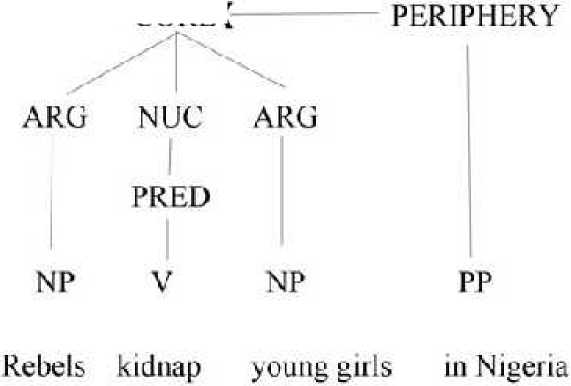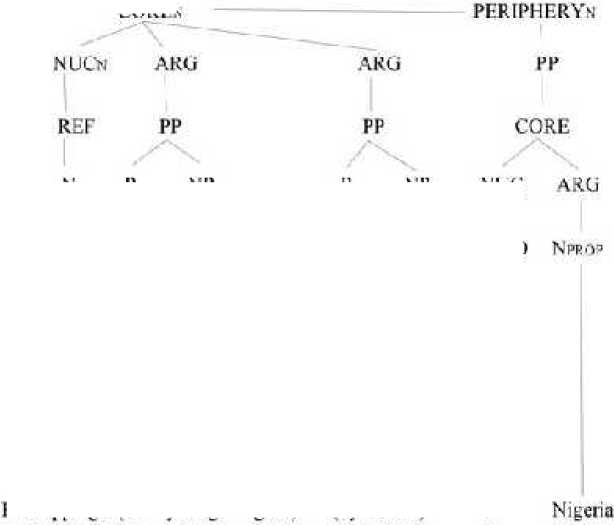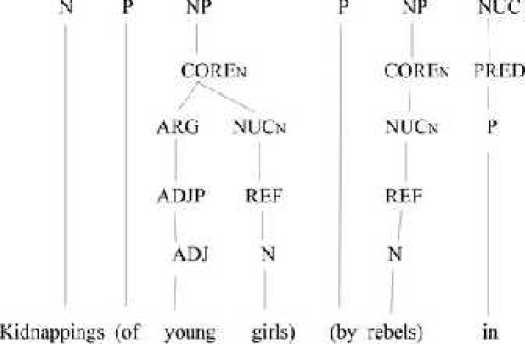SYNTACTICAL ANALYSIS OF NEWSPAPER HEADLINES
on
1
SYNTACTICAL ANALYSIS OF NEWSPAPER HEADLINES
by
Fitri Maharani
English Department
Faculty of Letters and Culture
Udayana University
Abstrak
Kepala berita kerap menjadi hal pertama yang terlihat pada surat kabar dan memiliki pengaruh besar bagi pembaca dalam memutuskan untuk membaca berita tersebut atau tidak. Dalam segi bahasa, kepala berita memiliki konstruksi yang berbeda dengan struktur kalimat standar bahasa Inggris—Crystal menyebut fenomena linguistik ini dengan nama “block language”. Oleh karena itu, studi ini menganalisa sintaks dari kepala berita dengan mengklasifikasikan jenis-jenis kepala berita beserta konstruksinya dan menjelaskan perbedaan struktur atau konstruksi kepala berita dengan bahasa standar. Data penelitian ini dikumpulkan dari empat surat kabar berbahasa Inggris, yaitu The International New York Times, China Daily, The Jakarta Post, dan Bali Times. Sebanyak 200 kepala berita diklasifikasikan dan diuraikan berdasarkan teori-teori sintaks oleh Quirk et al, Crystal, Van Valin et al, dan Swan.
Kata kunci : kepala berita, sintaks, struktur kalimat
Headlines are often first thing the readers come across in newspapers. It is also generally established that journalistic language, in particular headlines, has its own characteristic that can clearly be distinguished from the ordinary English language. Due to the constraint of space, headlines are displayed differently from construction of the common core—defined as a range of linguistic features found in all varieties, dialects, etc. of a language including their basic rules of word order, word formation, as well as high frequency vocabulary (Crystal, 2003: 85).
This study analyzed the syntax of headlines, focusing on the types of headlines, especially the difference between sentential and non-sentential headlines and their structures; in addition to determining the specific grammatical features of headlines that deviate from the norm of the language, known as block language.
According to the background presented above, there are two problems related to and discussed in this study. The problems are formulated into:
-
1. What are the types of newspaper headlines?
-
2. What are the grammatical characteristics of newspaper headlines?
The followings are the aims related to this study . They are:
-
1. To identify the types of newspaper headlines.
-
2. To describe the specific grammatical characteristics newspaper headlines.
The data source of this writing was newspapers in English that were published on the second weekend of May 2014 (May 16th and 17th), namely The International New York Times, China Daily, The Jakarta Post, and Bali Times.
A library research method with the technique of note taking was used in this research. The process of collecting the data involved reading each newspaper thoroughly and identifying the headlines. Note-taking in order to compile a corpus of 200 headlines selected at random, followed this.
The methods of analyzing the data were both quantitative and qualitative. Numbers were required in answering the first problem in which the frequencies of the headlines were analyzed. Each headline was classified and described based on
the theory of syntax followed by collecting numerical data; it is related to the percentage of each type of headlines.
Based on the sentence construction, headlines are classified into two major types which are sentential headlines and non-sentential headlines. It appears that the most frequent headlines are sentential headlines with 139 headlines out of 200 compiled within the corpus, making up the majority with 65.9%.
Headlines with regular sentence structure, i.e. headlines with a subject and a finite verb phrase occurred the most frequent, dominated by simple sentences containing one independent clause with 117 occurrences.
SENTENCE
CLAUSE
CORE
ARG NUC ARG
PRED
NP V NP
FcrTiigiirno Iuurithcs Fiurnniu bug
-
Figure 1. The LSC diagram of simple sentence
The headline Ferragamo launches Fiamma bag is constructed from one single independent clause with one subject which is the NP Ferragamo and one finite verb phrase launches Fiamma bag. The LSC construction shows that the sentence consisted of one core and one nucleus, further cemented it as a simple sentence.
Concerning the clause types, the most frequent type was S-V-O with 76 occurrences. The probable reason for favoring this type could be the fact that it best describes in the best suitable way “who did what”. The subject is almost always present, clearly enhancing the readers’ understanding of the “do-er”. The only exceptions are headlines with imperative structure, as they are characterized with implied subject.
There were 22 headlines identified as headlines with a regular multiple sentence structure, all of which are classified as complex sentence.
SENTENCE
CLAUSE
CORE
CORE
PERIPHERY
ARG
NUC
ARG
NUC
PREC
PREC
awareness grows, victim comes
forward
-
Figure 2. Clausal Juncture in complex sentence
The headline As awareness grows, victim comes forward represent a complex sentence construction with an independent clause and a dependent clause. The NP victim and VP comes forward, a subject together with finite verb phrase, make up the main clause. On the other hand, the second clause is marked with subordination by the conjunction as and maintains its role as the immediate constituent of the main clause. The clausal juncture pattern emerged in its construction.
In addition, in terms of the discourse functions presented by the headlines, it is apparent that statements prove to be the most popular function of headlines, largely overshadowing directives and questions in frequency. Unfortunately, there
is no exclamation to be found within the corpus, which does not necessarily mean that such headlines do not exist.
While the sentential holds the majority, within the corpus 61 headlines were constructed without a finite verb form or without a verb form at all. Structures with a verb phrase are non-finite clauses which occurred 32 headlines whereas structures without a verb phrase are just phrases.
In headlines with non-finite construction, an auxiliary verb is always omitted—the subject is always present, the verb is non-finite, and a form of the verb be may be added between them. This way, these headlines can be turned into regular sentences. This type of headlines is used to describe either a past event, which means that the omitted auxiliary is usually in the past or present perfect tense, or a future event, signifying that it is necessary to insert the auxiliary verb in the form of will, be going to or be to.
For instances, the headlines Three suspected MERS patients hospitalized can possibly be reinterpreted as Three suspected MERS patients was/ has been hospitalized. Others include Outlet malls outshining department stores across South Korea, Apple to unveil iPhone 6 in August, etc.
The phrasal headlines analyzed within the corpus amount to 29 headlines, all of which are noun phrase, and will be referred to as nominal headlines. Several headlines within the corpus are also representatives of deverbal nominal, having the same logical structure in their lexical entry as the corresponding verb.
NP
CORFa < PFRIPHFRYn
NUCn COREp
REF NUC ARG
N PRED NP
1’ NProp
Kidnappings in Nigeria
-
Figure 3. LSNP of deverbal headline
The noun kidnappings in the deverbal nominal headline Kidnappings in Nigeria, corresponds to the transitive verb kidnap. The arguments of the verb are realized as arguments of the nominal nucleus, and vice versa. To get the complete understanding, the derived nominal headline must be reconstructed into the original clause structure in which each argument is presented clearly alongside its discourse function for maximum comprehension. The verb kidnap is a transitive verb. In a sentence made up from the verb kidnap, the clause pattern that emerge is S-V-O which also allows for an optional adverbial.
SENTENCE
CLAUSE
CORE<

Figure 4. LSC of transitive construction
Comparing the nominal headline Kidnappings in Nigeria and the presumed sentential structure of the headline Rebels kidnap young girls in Nigeria, it becomes apparent that when the nominal was derived from the clause, specifically the transitive verbal construction of kidnap, there was a shift or an omission of two arguments which is the actor (S) and the undergoer (O) of the action kidnap. In its entirety, the derived nominal headline is constructed as shown by the figure below.
NP
CORFs


Figure 5. LSNP of the derived nominal headline in its entirety
Based on Swann’s and Quirk’s takes on block language, a combination of characteristics of block language are found within the corpus. They are noun strings (e.g. House bribery case, new community sanitation facility), special tense system (e.g. Suicide bomber attacks Anhui meeting), article drops (Arrest of 5 bombers in Uyghur), omission of the auxiliary verb to be (e.g. Outlet malls outshining department stores across South Korea, etc.), special use of passive voice (e.g. Thai drug smuggler busted at Medan), and omission of the introductory there (e.g. Fines for dropped calls in Malaysia).
Based on the analysis, headlines can be classified into sentential and non-sentential headlines. It is established that sentential headlines occurred more frequently (69.5%)—the most frequent being the simple sentences with the basic structure S-V-O. This figure supports the statement that the headlines containing a
verb form are regarded as more appropriate ones, as omitting verb within headlines construction obstruct the meaning perceived by the readers. In addition, the headlines were mostly statements, which acknowledge the essential function of a headline, namely to inform readers.
In comparison to the common structure, distinctive syntactical features represented in the headlines are noun strings, special tense systems, article drops, special use of passive voice, omission of auxiliary verb to-be, and omission of introductory there. This is in accordance with that lexical, not grammatical words are used, which is a characteristic feature of the language variety called block language.
Adamec, Peter. 2008. The Internet News Headlines : an Analysis (undergraduate thesis). Brno: Masaryk University Brno
Crystal, D. 2003. The Cambridge Encyclopedia of the English Language.
Cambridge : Cambridge University Press
Joseph, Bern. 2003. Grammar in Newspaper Headlines (undergraduate thesis).
Michigan: University of Michigan
Praskova, Eva. 2009. Grammar in Newspaper Headlines (undergraduate thesis).
Pardubice: University of Pardubice.
Quirk, R., et al. 1991. A Comprehensive Grammar of the English Language.
Longman Group Ltd
Swan, Michael. 1996. Practical English Usage. New York: Oxford University Press
Tinono, Nani I. 2008. The Analysis of Syntactic and Semantic Factors Found in Newspaper Headlines
Van Valin et al. 1997. Syntax : Structure , Meaning, and Function. New York : State University of New York
Discussion and feedback